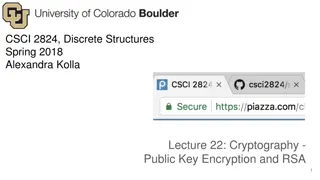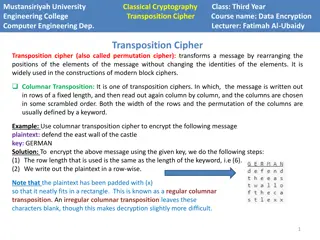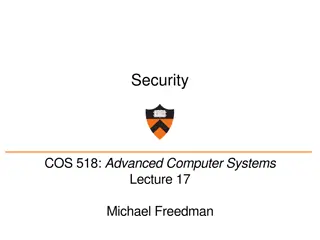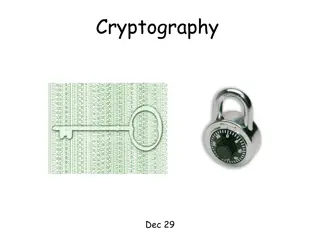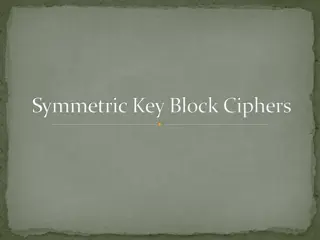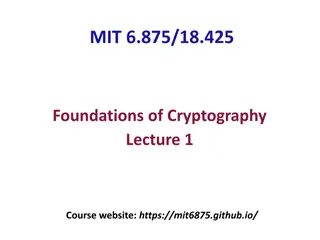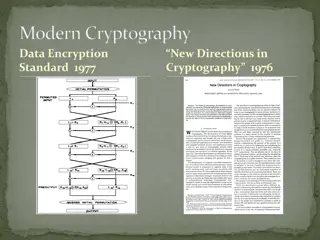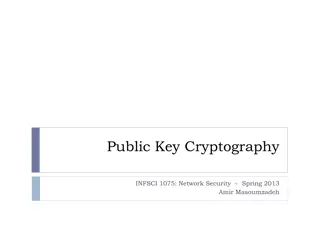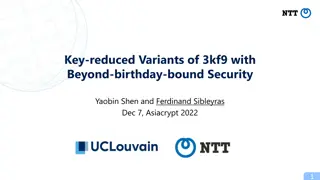Understanding Block Ciphers in Cryptography
Explore the principles of block ciphers in modern cryptography, focusing on the Data Encryption Standard (DES) and its design principles. Learn about block cipher encryption, Feistel block cipher structure, n-bit block ciphers, ideal block ciphers, key length considerations, and challenges with ideal block ciphers. Dive into the concepts of encryption, decryption, substitution, and the complexities surrounding block sizes and key lengths.
Download Presentation

Please find below an Image/Link to download the presentation.
The content on the website is provided AS IS for your information and personal use only. It may not be sold, licensed, or shared on other websites without obtaining consent from the author. Download presentation by click this link. If you encounter any issues during the download, it is possible that the publisher has removed the file from their server.
E N D
Presentation Transcript
Cryptography and Network Security Chapter 3 Fifth Edition by William Stallings Lecture slides by Lawrie Brown
Content Block Cipher Principles The Data Encryption Standard Simplified-DES DES Details DES Design Issues and Attacks 3DES, AES and Other Block Ciphers
The objectives now look at modern block ciphers one of the most widely used types of cryptographic algorithms provide secrecy /authentication services focus on DES (Data Encryption Standard) to illustrate block cipher design principles
Block Ciphers Encrypt data one block at a time Used in broader range of applications Typical block size 64 128 bits 128 bits Most algorithms based on a structure referred to as Feistel block cipher
Block cipher principles n-bit block cipher takes n bit plaintext and produces n bit ciphertext 2npossible different plaintext blocks Encryption must be reversible (decryption possible) Each plaintext block must produce unique ciphertext block Total transformations is 2n!
Ideal Block Cipher key is mapping ; Key length 16 4 bits = 64 bits . i.e. concatenate all bits of ciphertext table
Ideal Block Cipher n-bit input maps to 2n possible input states Substitution used to produce 2n output states Output states map to n-bit output Ideal block cipher allows maximum number of possible encryption mappings from plaintext block Problems with ideal block cipher: Small block size: equivalent to classical substitution cipher; cryptanalysis based on statistical characteristics feasible Large block size: key must be very large; performance/implementation problems Key length : In general, key length is 2n n Actual block size is at least 64 bit ( Key length will be 264 64 1021 bits)
Feistel Structure for Block Ciphers Feistel proposed applying two or more simple ciphers in sequence so final result cryptographically stronger than component ciphers n-bit block length; k-bit key length; 2ktransformations (rather than 2n !) Feistel cipher alternates: substitutions, transpositions (permutations) Applies concepts of diffusion and confusion Applied in many ciphers today Approach: Plaintext split into halves Subkeys (or round keys) generated from key Round function, F, applied to right half Apply substitution on left half using XOR Apply permutation: interchange to halves implements Shannon s S-P net concept
Confusion and Diffusion Diffusion Statistical nature of plaintext is reduced in ciphertext E.g. A plaintext letter affects the value of many ciphertext letters How: repeatedly apply permutation (transposition) to data, and then apply function Confusion Make relationship between ciphertext and key as complex as possible Even if attacker can find some statistical characteristics of ciphertext, still hard to find key How: apply complex (non-linear) substitution algorithm
Using the Feistel Structure Exact implementation depends on various design features Block size, e.g. 64, 128 bits: larger values leads to more diffusion Key size, e.g. 128 bits: larger values leads to more confusion, resistance against brute force Number of rounds, e.g. 16 rounds Subkey generation algorithm: should be complex Round function F: should be complex Other factors include fast encryption in software and ease of analysis Tradeoff : security vs performance
Data Encryption Standard (DES) Symmetric block cipher 56-bit key, 64-bit input block, 64-bit output block One of most used encryption systems in world Developed in 1977 by NBS/NIST Designed by IBM (Lucifer) with input from NSA Principles used in other ciphers, e.g. 3DES, IDEA Simplified DES (S-DES) Cipher using principles of DES Developed for education (not real world use)
Simplified DES Input (plaintext) block: 8-bits Output (ciphertext) block: 8-bits Key: 10-bits Rounds: 2 Round keys generated using permutations and left shifts Encryption: initial permutation, round function, switch halves Decryption: Same as encryption, except round keys used in opposite order
S-DES Algorithm IP = { IP = { 2 2, , 6 6, , 3 3, , 1 1, , 4 4, , 8 8, , 5 5 , , 7 7 } } IP IP - -1 1= { = { 4,1 4,1 , ,3 3 , ,5 5 , ,7 7 , ,2 2 , ,8 8 , , 6 6} }
S-DES Key generation P P10 10 = { = { 3 3, , 5 5, , 2 2, , 7 7, , 4 4, , 10 10, , 1 1, , 9 9, , 8 8, , 6 6} } P P8 8 = { = { 6 6, , 3 3, , 7 7, , 4 4, , 8 8, , 5 5, , 10 10, , 9 9} }
S-DES Encryption Details IP = { IP = { 2 2., .,6 6, , 3 3 , , 1 1 , , 4 4 , , 8 8 , , 5 5 , , 7 7 } } EP = { EP = { 4 4, , 1 1, , 2 2, , 3 3, , 2 2, , 3 3, , 4 4, , 1 1} } P4 = { 2, 4, 3, 1} IP IP - -1 1 = { = { 4 4., .,1 1 , ,3 3 , , 5 5 , , 7 7 , , 2 2, , 8 8 , , 6 6} }
S-Box S-DES (and DES) perform substitutions using S-Boxes S-Box considered as a matrix: input used to select row/column; selected element is output 4-bit input: bit1; bit2; bit3; bit4 bit1 , bit4 species row (0, 1, 2 or 3 in decimal) bit2bit3 species column 2-bit output
S-DES Example S-DES Example Plaintext: 01110010 Key: 1010000010 Ciphertext: 01110111 See the example detailes on the website
S-DES Summery S-DES expressed as functions: Security of S-DES: 10-bit key, 1024 keys: brute force easy If know plaintext and corresponding ciphertext, can we determine key? Very hard
Comparing DES and S-DES S-DES 8-bit blocks 10-bit key: 2 x 8-bit round keys IP: 8-bits F operates on 4 bits 2 S-Boxes 2 rounds DES 64-bit blocks 56-bit key: 16 x 48-bit round keys IP: 64 bits F operates on 32 bits 8 S-Boxes 16 rounds
DES Encryption Algorithm
Permutation Tables for DES 3: Expansion permutation (E ) 4 : Permutation Function (P)
Table 3.2 DES Example (Table can be found on page 75 in textbook) Note: DES subkeys are shown as eight 6-bit values in hex format
Avalanche Effect Aim: small change in key (or plaintext) produces large change in ciphertext Avalanche effect is present in DES (good for security) Following examples show the number of bits that change in output when two different inputs are used, differing by 1 bit Plaintext 1: 02468aceeca86420 Plaintext 2: 12468aceeca86420 Ciphertext difference: 32 bits Key 1: 0f1571c947d9e859 Key 2: 1f1571c947d9e859 Ciphertext difference: 30
Table 3.5 Average Time Required for Exhaustive Key Search
Key size Although 64 bit initial key, only 56 bits used in encryption (other 8 for parity check) 256 = 7.2 x 1016 1977: estimated cost $US20m to build machine to break in 10 hours 1998: EFF built machine for $US250k to break in 3 days Today: 56 bits considered too short to withstand brute force attack 3DES uses 128-bit keys
Attacks on DES Timing Attacks Information gained about key/plaintext by observing how long implementation takes to decrypt No known useful attacks on DES Differential Cryptanalysis Observe how pairs of plaintext blocks evolve Break DES in 247 encryptions (compared to 255); but require 247 chosen plaintexts Linear Cryptanalysis Find linear approximations of the transformations Break DES using 243 known plaintexts
DES Algorithm Design DES was designed in private; questions about the motivation of the design S-Boxes provide non-linearity: important part of DES, generally considered to be secure S-Boxes provide increased confusion Permutation P chosen to increase diffusion
Multiple Encryption with DES DES is vulnerable to brute force attack Alternative block cipher that makes use of DES software/equipment/knowledge: encrypt multiple times with different keys Options: 1. Double DES: not much better than single DES 2. Triple DES (3DES) with 2 keys: brute force 2112 3. Triple DES with 3 keys: brute force 2168
Double Encryption For DES, 2 56-bit keys, meaning 112-bit key length Requires 2111 operations for brute force? Meet-in-the-middle attack makes it easier
Triple Encryption 2 keys, 112 bits 3 keys, 168 bits Why E-D-E? To be compatible with single DES:
Summary have considered: block vs stream ciphers Feistel cipher design & structure DES details strength Doupbe DES Triple DES




